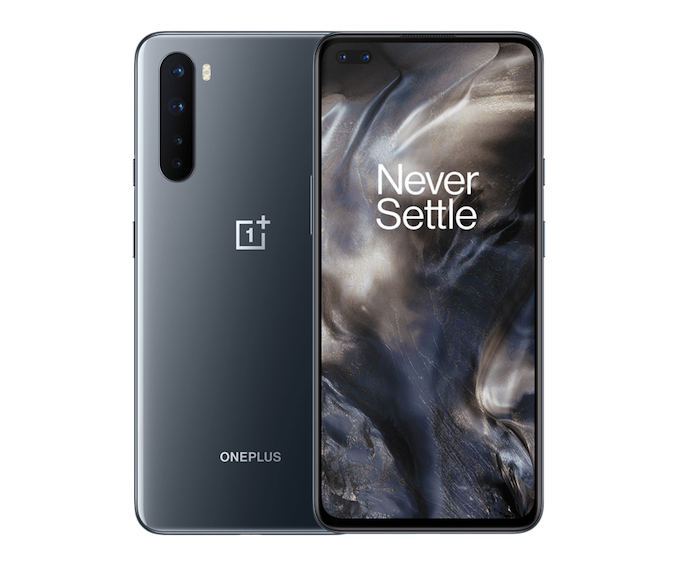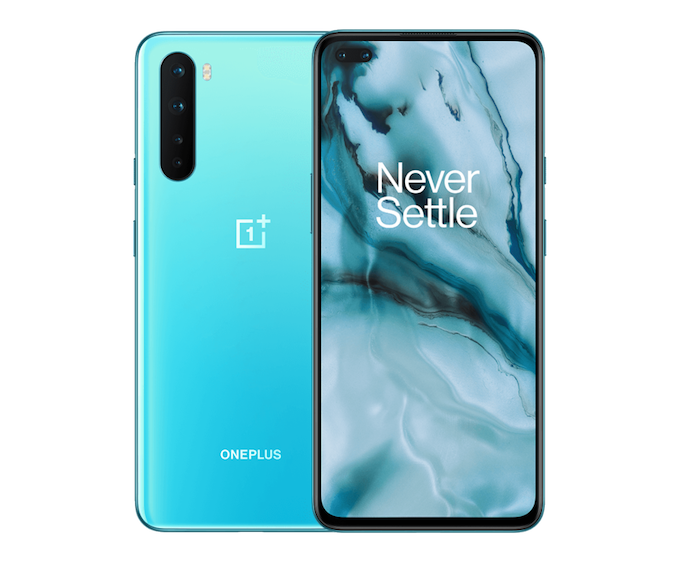OnePlus Announces Nord - Snapdragon 765 at 399€
by Andrei Frumusanu on July 21, 2020 12:00 PM EST- Posted in
- Smartphones
- Mobile
- OnePlus
- OnePlus Nord
- future-u

Today OnePlus is announcing its latest smartphone, the new OnePlus Nord. The Nord is a special device for the company as it’s the first time since its inception that we’re seeing a product release outside of the usual flagship line-up. The new Nord positions itself as a mid-range device in the “premium” category, coming with a Snapdragon 765 SoC as well as an attractive price point.
| OnePlus 2020 Devices | |||
OnePlus Nord |
OnePlus 8 | OnePlus 8 Pro | |
| SoC | Snapdragon 765 1x Cortex-A76 @ 2.3GHz 1x Cortex-A76 @ 2.2GHz 6x Cortex-A55 @ 1.8GHz Adreno 620 |
Snapdragon 865 1x Cortex-A77 @ 2.84GHz 3x Cortex-A77 @ 2.42GHz 4x Cortex-A55 @ 1.80GHz Adreno 640 @ 587MHz |
|
| Display | 6.44-inch FHD+ 2400 x 1080 (20:9) 90Hz Refresh Rate |
6.55-inch FHD+ 2400 x 1080 (20:9) 90Hz Refresh Rate |
6.78-inch QHD+ 3160 x 1440 (19.8:9) 120Hz Refresh Rate |
| SAMOLED | SAMOLED HDR10+ |
||
| Dimensions | 158.3 x 73.3 x 8.2 mm 184 grams |
160.2 x 72.9 x 8.0 mm 180 grams |
165.3 x 74.4 x 8.8 mm 199 grams |
| RAM | 8/12GB LPDDR4X | 8/12GB LPDDR5 | |
| NAND Storage |
128/256 GB UFS 2.1 | 128/256 GB UFS 3.0 | |
| Battery | 4115mAh (15.84Wh) typ. | 4300mAh (16.55Wh) typ. | 4510mAh (17.36Wh) typ. |
| 30W Fast Charging | |||
| - | 30W Wireless Fast Charging (only via proprietary charger) 10W Qi Wireless Charging |
||
| Front Camera | 32MP IMX616 f/2.45 + 8MP f/2.45 108° Ultra-wide |
16MP f/2.0 |
16MP f/2.4 |
| Primary Rear Camera | 48MP 0.8µm 1/2" IMX586 (12MP 1.6µm 2x2 binning) f/1.75 w/ OIS |
48MP 1.12µm 1/1.4" IMX689 (12MP 2.24µm 2x2 binning) f/1.78 w/ OIS |
|
| Secondary Rear Camera |
8MP Ultra-Wide-Angle f/2.25 119° FoV |
16MP Ultra-Wide-Angle f/2.2 116° FoV |
48MP Ultra-Wide-Angle f/2.2 120° FoV |
| Tertiary Rear Camera |
2MP Macro Camera f/2.4 |
8MP Telephoto f/2.4 |
|
| Extra Camera |
5MP Depth Camera | - | 5MP Colour Sensor f/2.4 |
| 4G / 5G Modem |
Snapdragon 5G Integrated X52 (LTE Category 18/13) DL = 1200 Mbps UL = 150 Mbps (5G NR Sub-6) DL = ? UL = ? |
Snapdragon 5G Snapdragon Modem X55 (Discrete) (LTE Category 24/22) DL = 2500 Mbps - 7x20MHz CA, 1024-QAM UL = 316 Mbps 3x20MHz CA, 256-QAM (5G NR Sub-6) DL = 7000 Mbps UL = 3000 Mbps mmWave for OnePlus 8 (non-Pro) on Verizon in the US |
|
| SIM Size | NanoSIM + NanoSIM | ||
| Wireless | 802.11a/b/g/n/ac BT 5.1 LE, NFC, GPS/Glonass/Galileo/BDS |
802.11a/b/g/n/ac/ax BT 5.1 LE, NFC, GPS/Glonass/Galileo/BDS |
|
| Connectivity | USB Type-C no 3.5mm jack |
||
| Special Features | On-screen fingerprint sensor | ||
| IP68 Rating | |||
| Launch OS | Android 10 w/ Oxygen OS | ||
| Launch Prices | 8+128GB: £379 / 399€ 12+256GB: £469 / 499€ |
8+128GB: $699 / 699€ 12+256GB: $799 / 799€ |
8+128GB: $899 / 899€ 12+256GB: $999 / 999€ |
Spec-wise, the phone is powered by the Snapdragon 765 SoC which is beginning to see a lot of traction in this mid-range/premium category of devices. Generally, the SoC is somewhat on par with a Snapdragon 845 in terms of CPU performance and on par with an 835 in GPU performance, so there’s still quite a bit of a performance differentiation compared to its primary devices.
Albeit priced more aggressively, the Nord isn’t all that much of a slouch with its 8 and 12GB LPDDR4X RAM configuration, as well as featuring 128 or 256GB of storage, although the interface here uses an older UFS 2.1 implementation.
Other areas where there have been compromises in specifications are the weaker WiFi chipset which doesn’t feature WiFi 6/ 802.11ax connectivity, although everything else is functionally on par with the OnePlus 8.
Design-wise, the phone keeps things simple although still quite premium. We’re seeing an 6.44” 90HZ 1080p OLED display which at this price range is a winning combination, making it on par with the OnePlus 8 although some features such as HDR+ have been shelved.
OnePlus has opted for a dual-front camera design with a primary 32MP sensor and a secondary 8MP ultra-wide module for wider selfie captures and video – a bit unusual given the higher-end flagships just have a single camera module. The camera hole-punch design reminds us of the Oppo Reno 3 Pro – certainly both phones share similarities given they’re manufactured in the same factories by the parent company.
Footprint-wise, the phone is similar to the OnePlus 8, and comes in at 158.3 x 73.3 x 82.2mm which is a sweet-spot form-factor. The weight is also very similar at 184g. Battery-wise, OnePlus was still able to house in a 4115mAh battery which is slightly smaller than the OnePlus 8’s.
Lastly in terms of rear camera configuration, the Nord features the same IMX586 main camera found on the OnePlus 8, which probably is amongst its most interesting value propositions. Although this module faired adequately in the OnePlus 8, it’s a good match for the Nord’s price point.
In addition to the main camera we also see a 8MP ultra-wide module which likely won’t be of great quality, as well as an extra 2MP macro sensor just like on the OP8, as well as an additional 5MP depth camera for helping portrait mode photography.
399/499€ starting August 4th
The Nord is debuting in European and Asian markets first on August 4th, with a tentative release in North America later. The phone comes priced in at £379/399€ for the standard 8/128GB variant, and £399/499€ for the 12/256GB model.
The phone vastly undercuts similar devices such as the recently released LG Velvet as well as OPPO’s own Find X2 Neo whilst essentially being on par in terms of specifications – I see the Nord becoming extremely popular and successful due to its aggressive pricing.













61 Comments
View All Comments
MooseMuffin - Tuesday, July 21, 2020 - link
I hope this is a sign that companies are going to really compete in the sub-$500 price point again.quiksilvr - Tuesday, July 21, 2020 - link
I am actually surprised that Apple is leading the charge on this. They already have a super affordable $399 phone with a flagship processor (albeit on a dated design) but their flagship flagship phone goes for under $700 now (and if the rumors are true for iPhone 12, even cheaper than that). I was really disappointed in Samsung for not only getting rid of the headphone jack but also getting ride of their affordable flagship series the S10E with no S20E. Here is hoping this holiday season will incentivize other manufacturers to do so. I doubt OnePlus will make a huge change in this space; my only hope is other Chinese brands go with a cleaner Android look rather than a bloated mess they have now.serjrps - Tuesday, July 21, 2020 - link
Here in EU they're not "leading" in that sense since iPhone SE costs round 499 EUR here (PT price, translates to about 573 USD), which is a large jump up from US price, even considering the added VAT.It's a good entry point if you want to be in the Apple ecosystem, but for 500€ you can get plenty of good smartphones, especially from Realme / Xiaomi. Now Oneplus got back into the scene. I hope they give at least 3 years of support to the phone, it's about time they creep up to Apple in that regard.
sonny73n - Tuesday, July 21, 2020 - link
“I hope they give at least 3 years of support to the phone, it's about time they creep up to Apple in that regard.”Did you mean system firmware updates? If you did, you shouldn’t compare Apple’s firmware updates to Android devices. We all know Apple is a crook. They always try to shove new firmwares down your throat just to slow down your phones.
Apple sheeps can go claim a part of $500 millions class action lawsuit here:
https://www.smartphoneperformancesettlement.com/
Fulljack - Wednesday, July 22, 2020 - link
the problem is that Apple did not disclose to it's user. Apple did not nerf your phone performance do you would buy their new device, but to help save it's battery life.if Apple deliberately slows down your phone performance for planned obsolescence, then iOS 12 shouldn't improve performance at all, yet it did as shown by Ars Technica iOS 12 review
Skeptical123 - Wednesday, July 22, 2020 - link
"We all know Apple is a crook. They always try to shove new firmwares down your throat just to slow down your phones." everyone just ignore the kids/trolls they love starting flame wars for stuff the is widely debunked...sonny73n - Tuesday, July 21, 2020 - link
You’re talking about 3GB RAM (LPDDR3?) vs 8GB LPDDR4X, 64GB ROM vs 128GB, 1821mAH vs 4115mAH, tiny IPS vs 6.44 in. 90Hz SAMOLED....etc. LAME!Until the day that you can install Android on iOS to benchmark those Apple’s processors so you can compare those results to Android’s Snapdragons’ fairly... In the mean time, your praise for Apple’s processors is obsolete.
In case you didn’t know, you can always root an Android phone and install a pure version of Android on it.
iphonebestgamephone - Wednesday, July 22, 2020 - link
What about windows and android? 8cx on windows and 855 on android gave similar benchmark scores.And you just cant root any android phone either. You have to make sure the oem allows bootloader unlock, the phone us popular enough to have custom roms, the dev actually provides support, etc. Or you could make your own rom and install it.
Spunjji - Wednesday, July 22, 2020 - link
I'm not sure comparing raw specs like that is much help. The screen would be the most noticeable difference, with storage definitely being next, but battery capacity means nothing without knowing relative platform efficiency and the same goes for RAM. I remain completely unconvinced that there's any real practical point to having more than 4GB of RAM in a smartphone.I should note that I'm not really defending Apple here. The iPhone SE2 looks like good value if you consider the SoC you get - or for some reason absolutely need an iPhone - but everything else about the design is woefully outdated. I'd have pointed at the camera setup as the biggest indicator that you're getting ripped off.
Rookierookie - Tuesday, July 21, 2020 - link
OnePlus has always been focused on the sub-$500 price point. It's only in the last couple of years that Chinese brands have made legitimate inroads in the high-end market.